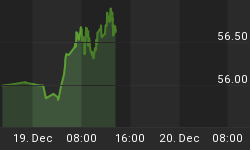October may turn out to be a difficult month for traders in U.S. equity indices. After most indices reached marginally higher highs in September, they retreated quickly to break beneath recent lows and beneath trend line and channel supports. Although our analysis suggests those developments were the beginning of a much larger decline, we cannot yet rule out the possibility that September's weakness represents merely a corrective phase that would precede new rallies to higher highs.
As of this writing, we believe that the best trading approach is to sell from upward retraces, but the risk in doing so will remain substantial until we see yet more confirmation of a bearish market. Below, we offer our current analysis for two representative stock indices, showing how price has broken through layers of support that we had been watching.
The last time we addressed the New York Composite Index (NYA) publicly was in our September eBook, where we described our expectation for one more marginally higher high before a strong decline. Part of the basis for that prediction was the developing five-wave pattern on a weekly chart, when price looked as though it was climbing out of a fourth-wave correction. The inset in the upper-left corner of the NYA chart below shows what we published at the beginning of September.
After making the expected higher high in September, price began retreating and actually printed a full weekly bar below the near trend-line support last week. In addition, bears were able to force price down far enough to reduce the possibility of the move being a normal fourth-wave correction in the pattern that started at the beginning of 2014. The next confirmation of a bear market would be for price to break and close beneath the middle line of the channel shown on the chart.
The NYA is not traded directly with futures contracts, although there are a variety of other instruments that a trader can use to take a short position. In contrast, the Russell 2000 Index is traded with futures and options, and its recent weakness has already made for some successful trades.
As with the NYA chart, the Russell chart below includes an inset that shows what we published at the beginning of September. The Russell had already seen a very slightly higher high during the summer, followed quickly by a test of the mid-line of the channel - a sign of weakness, although not definitive. Our September analysis included typical retracement levels that the index would make if it were climbing in a corrective wave before resuming a downward trend.
As you can see with the main part of the Russell chart, price fell hard from the area of the prominent retracement values, and bears succeeded in pushing it considerably beneath the center of the channel. Although it is not yet a certainty, this could be the start of a powerful downward third wave.
Since this is a situation that can change rapidly, we encourage readers to check our website to find the most recent version of our daily chart for the S&P 500 (the index we track even more closely than all the others).

















